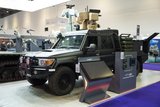Raytheon demonstrates new secure waveform
An unclassified but secure waveform has been used by Raytheon to transmit sensitive data through small, low-cost satellite terminals as part of a demonstration effort to make military satellite communications more affordable yet still highly secure.
The goal is to show that this approach could allow front-line tactical users, such as forward deployed forces or remotely piloted aircraft, to execute missions more securely and reliably than is now done in environments where communications can be jammed.
Raytheon’s demonstration used a small, lightweight, low-cost modem to show that key elements of the protected tactical waveform are similar to Advanced Extremely High Frequency, one of the military's most complex, and can be used to provide an affordable protected tactical solution.
Scott Whatmough, vice president of Integrated Communication Systems in Raytheon's Space and Airborne Systems business, said: ‘As the only provider of AEHF production satellite terminals to the military, Raytheon leveraged its protected military satellite communications leadership to meet the affordability, security and flexibility challenge.’
According to the company, key cost benefits and modem features were identified and demonstrated allowing for flexibility across frequency bands that will provide tactical users the communications protection they need at affordable prices using existing and future satellites. The new tactical waveform can operate on a variety of bands including Q, X and Ka. It provides secure, anti-jam, low probability of intercept capabilities not available today on unprocessed or unprotected satellites.
The waveform demonstration is part of a three phase US Air Force study known as the Design for Affordability and Risk Reduction.
More from Digital Battlespace
-
![Babcock nears first customer for Nomad AI translation tool]()
Babcock nears first customer for Nomad AI translation tool
Nomad can provide militaries with real-time intelligence, saving critical time on the battlefield.
-
![AUSA 2025: Israel’s Asio Technologies to supply hundreds of improved Taurus tactical systems]()
AUSA 2025: Israel’s Asio Technologies to supply hundreds of improved Taurus tactical systems
Taurus operates alongside the Israel Defense Forces’ Orion system which supports mission management across tens of thousands of manoeuvring forces, from squad leaders to battalion commanders.
-
![AUSA 2025: Kopin pushes micro-LED plans as China moves faster]()
AUSA 2025: Kopin pushes micro-LED plans as China moves faster
The plan for the new displays follows fresh investment in Kopin’s European facilities by Theon and an order for head-up displays in fielded aircraft, with funding from the US Department of Defense.
-
![AUSA 2025: Persistent Systems to complete its largest order by year’s end]()
AUSA 2025: Persistent Systems to complete its largest order by year’s end
Persistent Systems received its largest ever single order for its MPU5 devices and other systems earlier this month and has already delivered the 50 units to the US Army’s 4th Infantry Division.
-
![Aselsan brings in dozens of companies and systems under the Steel Dome umbrella]()
Aselsan brings in dozens of companies and systems under the Steel Dome umbrella
Turkey has joined the family of countries attempting to establish a multilayered air defence system with government approval in August 2024 for the effort landed by Aselsan. Dubbed Steel Dome, the programme joins Israel’s Iron Dome, the US Golden Dome, India’s Mission Sudarshan Chakra and South Korea’s low-altitude missile defence system.
-
![DSEI 2025: MARSS unveils new agnostic multidomain C4 system]()
DSEI 2025: MARSS unveils new agnostic multidomain C4 system
MARSS’ NiDAR system has been deployed using sensors from static platforms to provide detection and protection for static sights, such as critical infrastructure, ports and military bases.




























